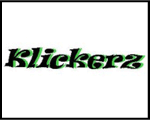|
If
you use a DDN enabled registrar you will soon be able to upload
your domains for sale through that registrar and they will
appear across the network (this functionality is already in
place at Fabulous.com). Sellers have to set prices between
$350-$5,000 which Warner said covers the price range commanded
by 90% of current sales. DDN’s current distribution partners
include GoDaddy, Tucows, Moniker and Fabulous
with others signed
that are to be announced soon.
|

|
Selling
through registrar sites have several advantages including brand
name recognition. For example, people trust the GoDaddy name more than the
name of an unknown seller. Also, registrars are the only ones
who can guarantee that the domain is owned by the person listing
it and that it is actually available for sale. Warner said that kind of
“quality control” currently does not exist.
|
Warner
said another major plus is that people searching for new
registrations who then discover the aftermarket represent an
entirely new source of traffic for domain sellers. Many current
sales occur from traffic generated by the owner’s domains
themselves – that is someone types in the name and discovers
it is for sale through that method.
Registrars
have already become one-stop shops where customers can get a
domain name, hosting, development services, software, etc. so Warner feels this also makes them a logical candidate to be
the primary source for aftermarket sales.
While
DDN is frequently compared to NameMedia’s AfternicDLS, Warner
said NameMedia (and other sales venues) are not competitors.
“DDN is not a reseller. It doesn’t compete with Name
Media, Sedo, Afternic or GreatDomains – which are all legacy
reseller portals. Legacy portals that believe DDN is a
competitor are misguided. The network simply enables
registrars to access contextual GEO sensitive technology, and a
database of domains which are pre-priced and available for sale
using an instant transfer protocol,”
Warner said.
“Registrars
are the only ones who can guarantee a person actually owns a
domain (when it is registered with them). They are also
the only ones that can instantly transfer those domains when the
domain owner has contractually entered an agreement to sell the
domain. Due to this they are the natural companies for
domain owners to work with to enable global distribution of
their domains. Registrars are the only ones that can
provide these checks and balances that are required to
seamlessly run transactions – comparatively legacy portals are
flying blind with no safety net,” Warner said.
| "Name
Media is frequently compared to the Domain Distribution Network
although they are not a competitor. They are the leading
aftermarket incumbent that is very good at selling their own
domain names. However, in contrast they are directly in
competition with the registrars for market share on domain sales
and now hosting and marketing services. It is easy for the
market to be confused by this, but the only way DDN competes
against Name Media is by enabling the registrars who are their
|
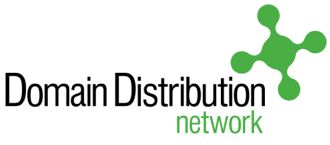
|
|
most serious competitors. Registrars are destined to
control most of the domain aftermarket for domains under $5,000.
Due to the scale and brand of the registrars it will be very
difficult for the legacy domain portals going forward to compete
against the registrars,”
Warner opined.
|
Though
it is a new entity, Warner said DDN is quickly reaching critical
mass. DDN was seeded with the hundreds of thousands of domains
directly owned by Fabulous.com but Warner said that is just the
start. “The DDN domain database is just about to get much
larger. Registrars are beginning to roll out the second
phase of the DDN implementation which enables a Registrar to
upload and manage domains directly into the DDN system.
You will shortly be able to go into your account with most
registrars and manage your global domain sales seamlessly
through your normal registrar interface.This new
innovation will not only enable domain sale functionality in a
proactive secure environment, but will encourage recruitment of
new domains for distribution that currently are not being used
by registrants -domains that were previously completely
inactive, even from a traffic perspective. GoDaddy.com and
Moniker.com will be going live with their owner side instant
sale protocol within weeks,”
Warner said.
“The
registrars are seriously seasoned competitors which add new
traffic and exposure to the domain aftermarket. DDN
enables the registrars to interact with each other, collects and
distributes vetting data on domains, centralizes global domain
distribution, and offers real time communication and settlement.
It provides a completely new source of domain sales traffic.”
|

|
Warner
also noted “Brand has become one of the defining issues
related to market share of the domain aftermarket. Our
research has shown that through the use of co-branding and sales
of domains via banners (directing sales traffic through to
registrars like GoDaddy) that a 150% increase in sales volume
can be achieved compared to conversions through sales portals.
When brand is proven to be this powerful and important to the
sales process, every domain portal manager should be rethinking
their current aftermarket sales strategies. Why would
anyone send traffic from their domains to a legacy portal when
they can send it to a registrar with a commonly known brand?”
he asked.
When
comparing the DDN system to other options Warner said you have
to ask these questions: What are the other provider comparisons
to DDN? Do competing technologies use contextual search
or only simple character string matching? Are their search
results
|
| relevant to location specific domains? Does
the competing solution steal the customer away from the party
providing the lead? Is there an absolute guarantee that
the domains in their database are still actively for sale or
that is isn’t fraud? Can a competing solution instantly
sell, settle and transfer domains in real time for third parties
(their domains shouldn’t be an issue and enabling only their
own domains doesn’t really count)? Does their solution
transfer domains and interact between different registrars in
real time? Are variable commissions supported on a domain
by domain basis so all domain stock is actually distributed?
What protection is in place to protect distribution partners
from legal conflicts caused by a lack of stock control?
Are the registrars they claim to have distribution deals with
the biggest registrars or just a supporting cast? Is the
distribution in-line, on the same page as the new registration
process? |
“The
Domain Distribution Network is a technological leader and a
value innovator. If a provider cannot provide at least the
basics in the preceding paragraph then they are not a comparable
provider,” Warner declared.
| Warner
has long been an advocate for making sales a key component of
any domain investment strategy. He told us, “The question to
sell or not to sell is principally an economic question.
Domain owners often look at their domains as if they were their
children. In reality they are only linear strings of
alphanumeric characters which are easier to type in than an IP
address."
"The question I like to pose is, “What revenue
multiple would you sell your whole portfolio for?” (not that I
believe in revenue multiples to determine domain sale values).
The answer usually is somewhere between 10 to 25 years revenue.
Then if you ask what is principally the same question in a
different way, “What would you sell
GenericDomainName.com for as a revenue multiple”, they usually
state some multiple that is 10 or more times the multiple of the
whole portfolio sale price. This is usually followed by a
statement that they don’t believe in selling domains. In
my view this is very flawed logic. People don’t believe
in selling domains at
|

|
| 50-500 year traffic revenue multiples, but
they do believe is selling their own portfolio for 15 to 25
years revenue? Now that doesn’t makes sense,”
Warner said.
|
“The
second argument is one that says that if they hold out they can
sell the same domains that they are not selling today for more
latter. To some degree that is true. However, the
stark reality is that even the best portfolios usually can only
sell 1% - 2% of their portfolio per year. In five years
time you may have missed the opportunity to sell say 10% of
your portfolio at 50-500 years traffic revenue multiple.
This doesn’t mean that all of a sudden you can sell 10% worth
of domains in the next year, and if you do want to sell more
then you will need to decrease your revenue multiple."
Warner
said, "The
most bizarre is when someone refuses to sell at these huge
retail revenue multiples, only to sell out later for a much
smaller multiple on the whole portfolio? Now, if you had
sold out that 10% at an average of a hundred year multiple (10%
x 100) and then sell the remaining portfolio at 15 years
multiple (90% x 15) = 2,350 vs. 1,500 if you wait.
This example shows that you lose 57% of the potential sale
revenue by waiting. Realistically, the domain prices will
go up, traffic revenue will be earned, and you may be burning
the furniture – but selling some domains all the time is a
much lower risk profile for your business and these rough
calculations still haven’t considered registration holding
costs or use of proceeds.”
“Lastly,
the theoretical portfolio of domains that don’t make back
their registration costs in traffic revenue. These domains
cost you money every year to hold them. The reality is
that every portfolio has a sub portfolio that is the same as
this theoretical portfolio. Ask the owner if they want to
sell the domains? The owner says no. Why? They
will be worth more in the future. So, you don’t want to
sell even though you don’t earn even your holding costs?
No, they are worth more than that. But, they don’t pay
for themselves? Yes, that’s right. Who’s on
First again? It is likely that on sale of your whole
portfolio that these domains will have little to no value
attributed the them and yet you still don’t want to sell
them?”
|

|
We
also asked Warner about the sustainability of the current market
boom (and how high the DDN system can fly if the sales
environment remains as friendly as it is today). “The domain
aftermarket after years of stagnation and a lack of innovation
is finally speeding ahead in leaps and bounds. The
Internet is a grand new experiment that is still cutting its
teeth, and yet everyone just happily accepted the status quo of
how aftermarket domain sales occurred. I found it bizarre
that systems that were built to enable the sale and transfer of
domain ownership would be so manual, poorly marketed, and
cumbersome. It is fantastic that so much new innovation
and marketing is occurring in the domain space. That
people are actively seeking new markets and scrapping legacy
systems and business models that were stale.”
|
“I
expect that domain values are going to strongly increase over the
next few years. The market is the market and now that it
is being more fully enabled it will find its way to a balance.
Like the stock market, domains should be seamlessly traded.
Their value should be what the market will bear and one cent
more than the under-bidder. All of the domains that are
not currently being used by authentic businesses should be
traded and sold until the single best use of each domain is
found or at least as close to a frictionless market that we can
get.”
“The
goal of the DDN system is to be the perfect enabler. Even
the 2% commission that the DDN takes as part of any transaction
is designed to be part of the market balance. The costs of
development, management, technical resources, and ongoing effort
of the DDN are roughly in balance with the expected
earnings from the endeavour. A higher commission
would have attracted hyper-competitors who would bid to control
a system which should be inherently an open platform for global
distribution. Even now it attracts competitors when no
profit is realistically to be gained. If the commission
were to be any lower the work that needs to be performed and the
robustness of the systems to run the network would be
compromised. The domain market would be a much better
place if companies sought value innovation over
hyper-competition. When aftermarket domain sales
transactions happen between all of the major registrars with
seamless transactions in real time, and the domain aftermarket
doubles in size to its current value – our goal will be
achieved.”
*****
Addendum
- Charts from DDN showing steadily growing sales revenue and
volume:
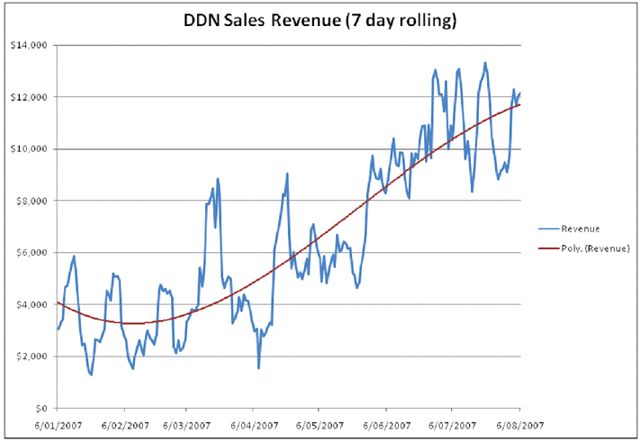
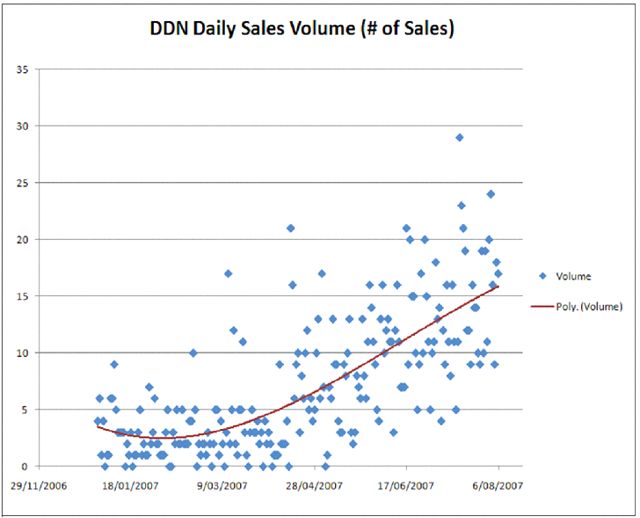
Some Other Interesting
Data from Domain Distribution Network Sales
• 55%
make less than $7 traffic revenue per year
• 36%
three words or more
• 24%
location based domains
• 10%
include a single hyphen
• 18%
have more than 20 characters in length
• 84%
have no heartbeat
• 25%
have no domain phrase search count
• 29%
have no domain phrase bids
• Profitable
domains (more than $7 traffic revenue) sell for > 50 years
traffic revenue
• Domain
Sales generated from 440,000 previously unprofitable domains now
more than cover their holding costs
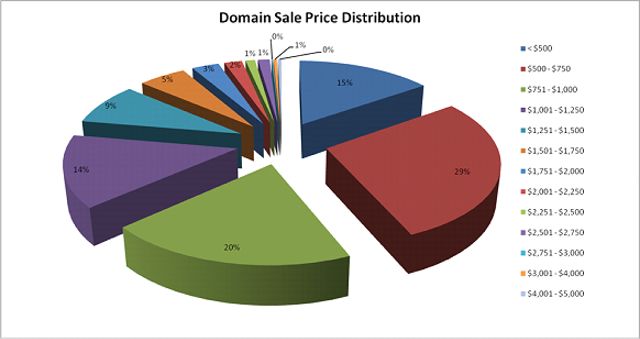


|


